By Thomas Müller (blog JungleOfCalais), published 17 February 2021. English translation by Kristina Koch.
For more than two decades the Northern French harbour and border town Calais has been the scene of unregistered migration from the European mainland to Great Britain (1). In the 1990s most people who stranded in Calais had come from former communist dictatorships in Eastern Europe or from war zones in the Balkans. Now they are mainly refugees from Afghanistan and Pakistan, from Eastern African countries such as Sudan, Ethiopia, Eritrea as well as from Iran and Iraq (Kurdistan). People from these regions make the largest part of the temporary migrant population in Northern France while number and share of the groups of origin vary.
Up to the mid 2010s many people who arrived in Calais had come to Europe via Mediterranean Sea or Balkan route. Later, the number of those increased whose asylum processes in other EU countries (often Germany) had failed; Great Britain had not been their primary destination.

„London Calling“: Graffiti on the edge of the Big Jungle and a destroyed Bansky mural (Photo: Th. Müller)
Not all of them live in Calais itself, they also use other towns as starting points for the passages to Great Britain: especially Grande-Synthe, near the harbour of Dunkerque, other French, Belgian, Dutch and Spanish ports in the reach of highways, and also Paris and Brussels. Thus, Calais is the center of a broad migration area between (temporarily) the Spanish ports of Bilbao and Santander in the South West, Luxembourg in the South East, the Belgian-German border near Aachen in the East, and Hoek van Holland in the North.
Calais’ border is – next to the Southern and South Eastern external borders of the EU – the most secrutised in the historic core area of European integration. This border regime has its origins in the fortified expansion of the traffic ways to Great Britain, which started at the turn of the millenium: fences, walls, surveillance technology, patrols, restrictions on movement, and glacis.
A local Calais newspaper estimates 65 km of new fences since 2015 (2). The effects of this border regime include the documentation of 299 deaths between 1999 and 2020 (3) – more than in any border area within the EU. Moreover, the expansion of the border fortifications minimized the accessible migration paths and gave way to a lucrative market for professional smugglers – called mafias.
Up to the Brexit the term „external border inside“ described the situation well. Since then the British Channel literally has become an external EU border – however, an external border exclusively for the prevention of emigration.
Just as the EU has extended its external border into its geographical forefield, e.g. to North Africa, and uses the sea as a natural barrier, Great Britain has also externalized its combat of migration into French territory; the Channel functions hereby as a small version of the Mediterranean Sea. In both places this does not bring about the end of migration but it forces migrants to stay longer in border areas and to search for remaining migration paths: risky and expensive.
And this is how the first provisional camps in Calais were established in the late 1990s. With the expansion of these temporary camps, a story began which should get international attention as the Jungle of Calais.
The Big Jungle of Calais
The term Jungle was created in the late 2000 years. It has its roots in „djangal/dzhangal“, a Pashtu word for the large camps in forests back then. Today it is still used for numerous camps, mostly large, complex or multiethnic.
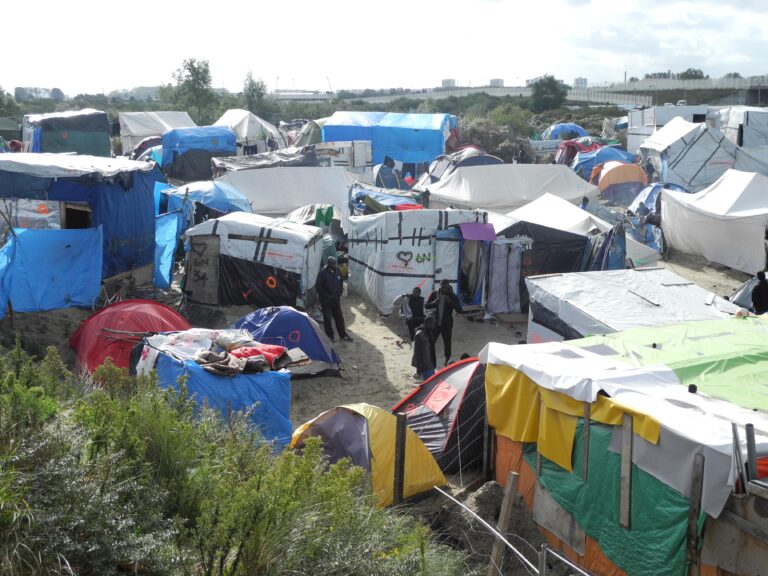
While several hundred persons – sometimes even up to over one thousand – lived in the past jungles, one particular camp (established through governmental interventions) within a short period of time grew into a settlement made of tents, shacks and containers for several thousand inhabitants. One and a half years later it contained over 10.000 people. Many of them had become homeless during their asylum process in France or while hoping to get accession to the French asylum system.
While the authorities called the settlement „La Lande“ (after the landfill site it was located on), it became publicly known as the epitome of The Jungle of Calais; also the retrospective term „Big Jungle“ describes its high dynamics (4).
The Big Jungle contained several institutions installed by the Government: a center with accession to meals, electricity and sanitary units (no accomodation though), an area to accomodate women and underaged youths as well as a container camp for persons aiming for accession to the French asylum system. The large part of the inhabitants lived in the „informal“ but government-„tolerated“ area though in which the authorities had prepared only simple infrastructure with a water point, a washing place, mobile toilets, garbage bins and street lanterns. They also tried to establish a sort of indirect management. This dual structure of official camp and wild camp resembled the camp of Moria prior to the fire in September 2020.
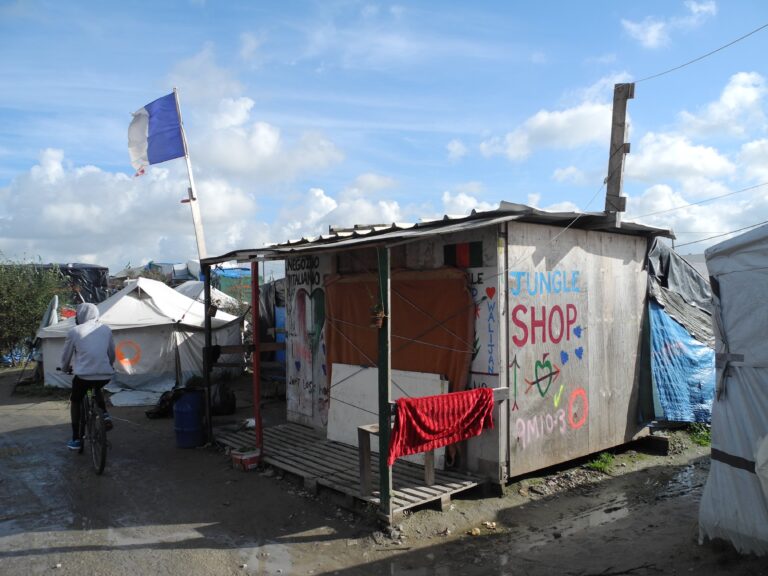
Most of the inhabitants of the Jungle provided for themselves or were supported by local civic organisations, professional NGOs as well as a large group of initiatives that were established spontaneously.
That way informal businesses, infrastructures and institutions were created: such as 70 restaurants, shops, cafes and other commercial enterprises, several mosques and churches as well as several informal schools, institutions for kids, recreation and culture, legal counselling, medical and psychological contact points, and a protected area for women and families with children.
Such diverse systems had already existed in other jungles and squats but the Calais jungle exceeded them in complexity and density. This development can be understood as a process of urbanisation, as the beginning of a transformation of the Big Jungle into a migrant city in the heart of Europe. Migrant researcher Michel Agier and architect Cyrille Hanappe analysed the conception of the Jungle as a city, they classified it into the global context of informal urbanisation and defended it as an alternative to hermetic camp structures. (5)
The Big Jungle was simultaneously an eminent political place. Already its location next to the access road to the ferry port meant that most ferry passengers must have caught a glimpse of it at the peak of the „European migration crisis“. Countless journalists – including the aggressive British tabloids – visited the Jungle but were more and more considered as a burden by its inhabitants: „We are not animals, and the Jungle is not a zoo!“
At the same time many political, educational, religious, cultural, artistic, media and academic initiatives involved the Junge into their networks – and turned it to a reference point and laboratory of civil society action.
The activist and artist Zimako Mel Jones suggested to use the name „forum“ instead of Jungle due to the colonial and racist connotations and because it had become a public place.
All of this does not relativise that the living conditions in the Jungle at that time were precarious. There was constant lack of supply, economical and sexualised exploitation as well as crime, including murder. There was collective violence, for example when in May 2016 a large Sudanese area was burned down by a group of Afghan inhabitants, without the French police intervening.
These problems are reflected in a number of surveys by the British initiative Refugee rights Europe who asked the inhabitants about their experiences with violence and fear. In these questionings it became obvious that people were mainly afraid of the police and often had experienced police violence themselves. (6)
These human rights abuses by the police – especially by the omnipresent Compagnies Républicaines de Sécurité (CRS) – have been and still are documented and denounced by activists (7), international NGOs (8)and official authorities, such as the Défenseur des droits (9).However, they take place unabated.
This review of the Big Jungle is essential to comprehend the situation after its evacuation in October 2016: The authorities had created this place consciously to remove the migrants from the public space of the city, to dissolve their scattered living places and instead, to gather them all in one place 7 km away from the city. However, they had not anticipated the attraction and dynamics, which the Big Jungle would unfold. Its evacuation became a giant, logistical operation: A large number of the inhabitants was taken to special Reception and Orientation centres (Centre d’accueil et d’orientation; CAO,) which had been installed almost all over France, except around Calais. A part of the unaccompanied underaged having relatives in Great Britain as well as those who fulfilled the additional age and nationality criteria were allowed to legally enter Great Britain for a while. The British government withdrew this option shortly after.
Since the evacuation the police focusses on the challenge of so-called fixation points (points de fixation). This term describes places of recently constructed camps which are urgently and continuously cleared: The police take or destroy the tents, cover other personal belongings, leading to constant stress, insecurity and lack of sleep for the affected persons. These early and constant evacuations make it legally impossible to achieve provisional tolerance. The aim is to prevent a second Big Jungle.
Calais as „a hostile environment“
The British Home Office Minister and later Prime Minister Theresa May coined the term „hostile environment,“ which was to be created for „illegal migrants“. (10)
The implementation of these claims on French territory represents how the French authorities clamped down on the „fixation points“.
It was to be expected that the destruction of the Big Jungle did not end the migration events in Calais. During the winter after the evacuation several hundred people – who had returned to Calais or who were new there – lived unprotected under bridges in the town centre, under balconies, in parks and even on sidewalks. By maintaining their tactics against the „fixation points,“ the police did not tolerate tents and covers so that people had to carry their sleeping bags and thermofoils around with them. During the same winter of 2017, the conservative mayor Natacha Bouchart ceased the help of humanitary organisations. When she grotesquely tried to prevent the Secours Catholique from providing shower cabins by blocking the road to their social centre with garbage containers, the story was shown all over the French media.
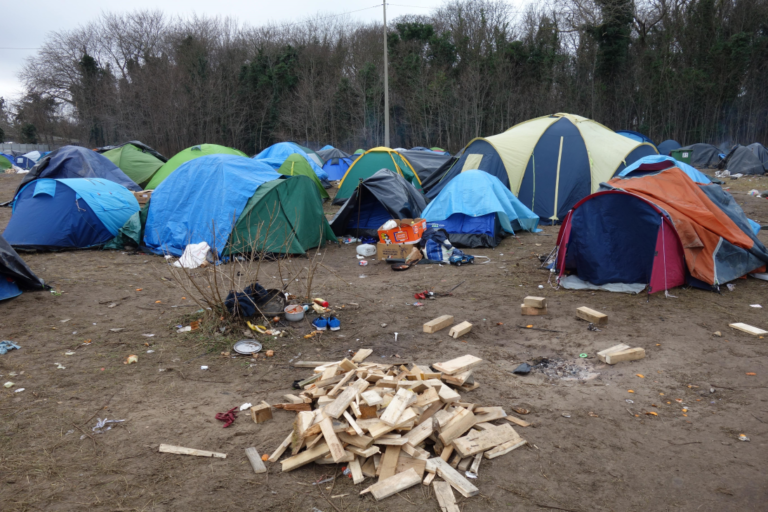
In the following years, initially the number of migrants increased to 400-700 in Calais with less in Grande-Synthe and Brussels. Very slowly, tiny camps came up as well as meeting points where Civil Society organisations provided meals, groceries and organised medical and legal help. Attempts of the authorities to block this help ended in legal disputes: The French High Court confirmed the inhumanity of the living conditions in Calais and obliged the authorities to provide accommodation and basic humanitarian supplies. On this basis the “Prefecture” gave orders to the humanitarian organisation La vie active (they had run the social center and container camp in the Big Jungle) to provide drinking water, meals and sanitary units. Moreover, voluntary transfers to special accommodation were organized. (Centres d_accueil et d’Examen des Situation, CAES.) These were located outside of Calais, like the CAOs. As a result of these transfers, a special type of alleged humanitary evacuation developed: during these mise à l’abri operations the inhabitants of the camps were taken by force to a CAES; afterwards their tents were taken away and when they returned thereafter they found themselves in an even worse situation.
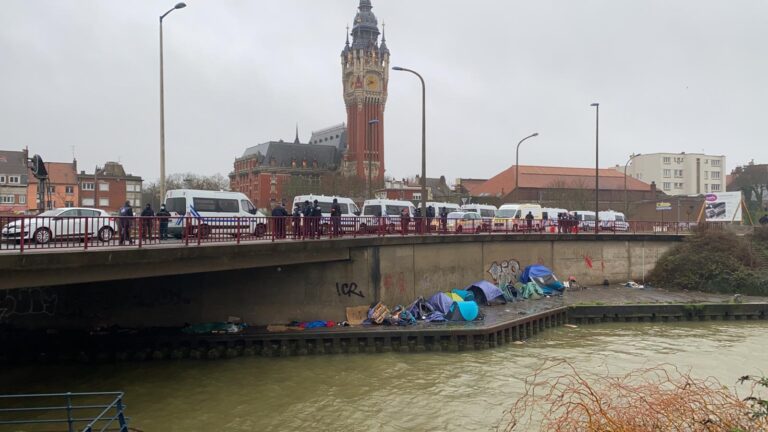
Up to 2018 a meeting point with several small camps existed in the industrial zone Zone des dunes. Since the 1990s this area had been the setting for many migration events of Calais. It was located near the harbour and included numerous infrastructures of truck traffic, which were mostly later closed. Also, the Big Jungle had been located right next to the Zone des dunes.
After this meeting point was evacuated in March 2019, the area was shut off with a massive fence. Later it became clear that this had initiated the fencing of all areas in the Zone des Dunes and the surrounding forests up until 2020.
In the meantime, La vie active established a spot with drinking water, meals and sanitary units on Rue des Huttes, a street at the other end of the Zone des Dunes, close to the former Big Jungle. Around this point migrants of various nationalities built up several new camps during 2019-20, which took up a considerable area and were called the New Jungle. The number of migrants increased to more than 1000, most of them lived in the Jungle. Some others lived in smaller camps, e.g. on wasteland at the Calais hospital.
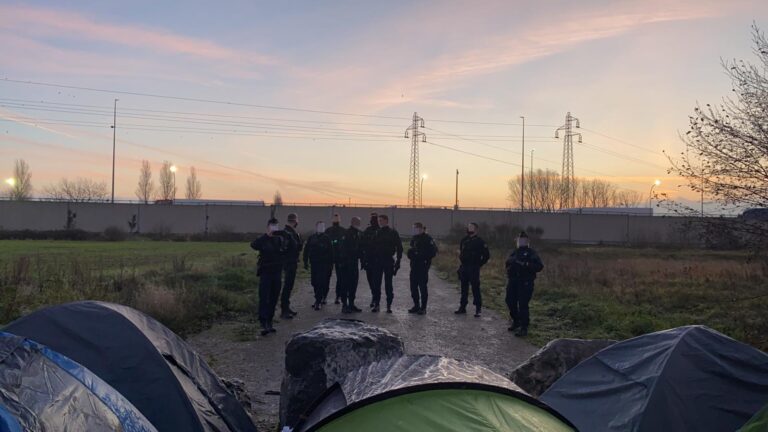
The Police acts against the „fixation points “did not cease but changed in character: Additionally the Jungle and the other camps were evacuated almost every 48 hours now. During these absurd operations officials searched these areas, from which the inhabitants moved their tents and restablished themselves and their belongings a few meters further or into the next street – in order to return after the officials had left. Two days later this procedure was repeated. Continuously repeating, this prevented longterm settlements and infrastructure as it had existed in the Big Jungle. It also made sure that the migrants lived under precarious living conditions and experienced a routine of continuous humiliation. For the years of 2019 and 2020 Human Rights Observers registered 961 resp. 973 evacuations in Calais being carried out in that way. (11)
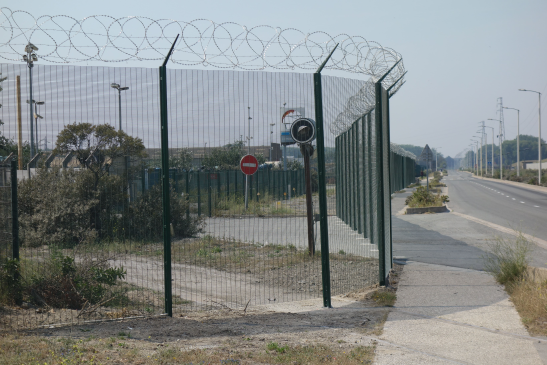
On 10 and 11 July the French Minister of the Interior Gérald Darmanin gave an order to evacuate the New Jungle and fence it off afterwards. (12) This evacuation was one of the first symbolic actions by the conservative minister and set up the stage for a meeting with his British colleague Priti Patel in Calais on 12 July; their main topic was how to combat clandestine boat passages.
A group of migrants settled on the wasteland at the hospital but the Hospital Jungle was also evacuated on 29 September 2020. (13)
After that the authorities kept an eye on the area of Forts Nieulay at the other end of Calais. (14) There, migrants tried to hide in trucks stuck in traffic jams (pre-Brexit).
Gérald Darmamin also banned the supply of food in certain areas of Calais if not under the authority of the government. (15) La vie active was the only organisation allowed to help everywhere in Calais. At first this ban was lifted on 11 September 2020 and has been continuously extended geographically since then. Providing or not providing humanitarian aid now served to put pressure on the 700 migrants in Calais and to regulate their presence in the diverse parts of the city.
The Corona pandemic has not changed the situation of the migrants. (16) During the two confinements, the authorities informed the inhabitants of the camps about social distancing, hygiene rules and curfews but they continued to destroy tents and take away personal belongings. Massive Police violence was also documented during that phase, such as the head injury of an Eritrean man from a rubber bullet (17). At the same time the authorities used the curfews to prevent the documentation of those operations.
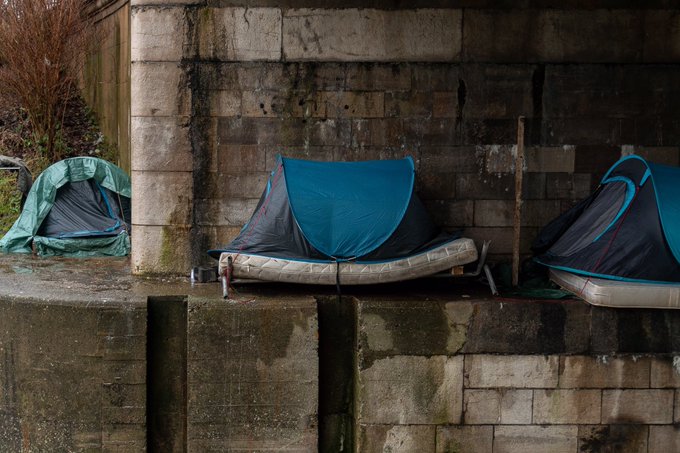
Soon it became obvious that the authorities in Calais were not prepared for the pandemic: They could not provide accommodation and the civil society organisations were left alone. The evacuation of the first inhabitants of the Jungle was planned for 31 March but did not happen after 5 cases of infection. In April voluntary and limited housing was provided in a newly established shelter outside of Calais with a capacity of 450 places. After a short time some people returned from there. Meanwhile the confinement resulted in a breakdown of the meals supply, which led to hunger. Therefore, the civil society organisations provided wood and groceries for cooking while La vie active provided lunch packages.
From Grande-Synthe, where the Authorities handled the situation in a similar way, disastrous physical conditions were reported at the beginning of the pandemic. During the second autumn confinement the Prefecture reestablished housing as well as search groups for obviously sick persons. By the end of the year 2020 there were no more supply problems comparable to those in spring.
The establishment of the Channel route
In the past 20 years many people have tried to cross the Channel both in small boats and by swimming. The movie Welcome from 2009 examines this issue, presenting a young man who after intense training tries to swim to England and dies. Nevertheless, until 2018 freight traffic was the most important migration path to Great Britain. Single migrants or small groups tried to hide in, on or under trucks or trains. Starting points were mainly gas stations or resting areas. With increasing policing of the traffic routes these areas were closed, moved or fenced in. On the one hand, groups of smugglers and commercial traffickers adopted access to such places and claimed money from the migrants; on the other hand, the activities at the motorways moved further inland, e.g. to the motorway Brussels-Oostende, towards Liège and Luxembourg.
Another migration technique is the use of traffic jams at the access roads to the Channel and to the harbours – or the creation of traffic jams by placing obstacles or by running onto the road. The most dangerous method was jumping from bridges onto moving trucks. Over and over again people were injured or died on the roads, on railway facilities and in cargo compartments: these being the most prevalent causes of death among those documented.
Such methods mean many unsuccessful and risky attempts over a long period of time and often payments of several hundred Euros. The alternative is commercial trafficking, for example with the help of cooperating truck drivers and costs of around 5000 Euros.
In October 2018 a new development arose which would unfold a similarly acute dynamic like the Big Jungle had done until October 2016: the boat passages increased. At first mainly Iranian migrants crossed the Channel: They had come by plane via Serbia and had not yet been traumatised by any boat passage. They used motorised dinghy boats , either legally bought or stolen. They were prepared for the passages organized by commercial traffickers in return for a payment of 3000-5000 Euros, or were self-organized in small groups. The French authorities reacted quickly by complicating the sales of boats and accessories such as life jackets and by encouraging the public to report possible preparations of such passages.
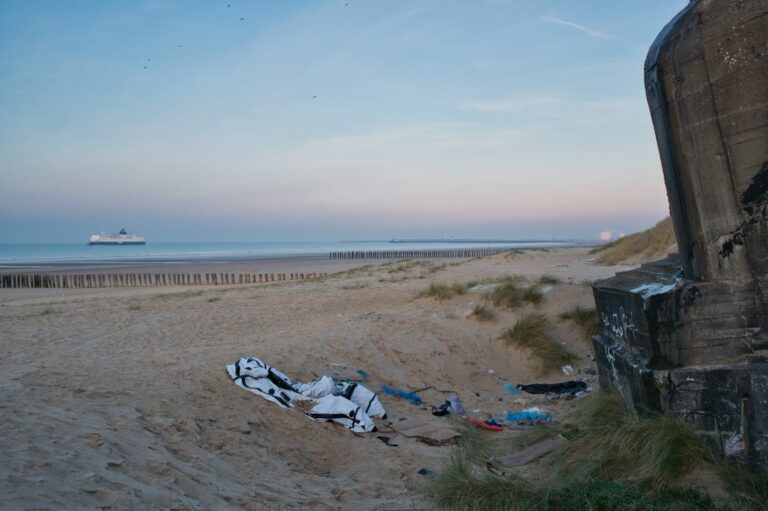
The exact number of boat passages varies in the different official sources. Fact is that 2018 about 300 people reached Great Britain by boat, around 90% between October and December with a first peak during the Christmas holidays. Following that, British tabloids and politicians started a populist campaign and depicted the arrival of this small group of refugees as an “invasion” and therefore addressed an effective narrative of British nationalism.
The Home Office Minister of the time, Sajid Javid, declared the boat passages as a “major incident” and ordered two Border Force patrol boats from the Mediterranean to the Channel while the Ministry of Defense prepared a battleship for the time until their arrival. (18)
On 24 January 2019, Javid and his French equivalent Mr Christophe Castaner signed a Joint Action Plan […] on combatting illegal migration involving small boats in the English Channel [19] in London. This plan regulated the cooperation of both countries during both search- and rescue and air patrol operations. Great Britain provided funds for patrols at sea, on the beaches and in coastal regions.
Moreover, the plan aimed for the quick deportation of a possibly high number of migrants to France. Since then, British politics has pulled through the idea of deterring future boat passengers via direct deportation. This concept would later be radicalised by Javid’s successor Priti Patel, who demanded pushbacks at sea.
During 2019 the boat passages were the most effective migration path: Between 1800 and 2000 boat passages succeeded, many more than the year before. A major incident happened at the start: on 2 March 2019 about 100-200 inhabitants of the Jungle stormed the site of the Calais Ferry Port and partly made it onto a ferry. This event was neither documented by journalists nor by local activists. While the Authorities blamed the smugglers, a Jungle activist described it to us as political protest, during which the people had taken the spontaneous chance to board an open ferry. According to him, some people had faced death by falling into the rough sea, others had made it to England – contrary to the reports of the Authorities. This event is relevant because at one of its most controlled places people were able to break through the Border regime in a collective activity, even if only partly.
Between 8400- 8700 people reached Great Britain in small boats during 2020: making a total of almost 11.000 since 2018. Even if this only makes up a small part of Immigration to Great Britain (45.000 asylum requests were submitted in 2020), the externalised border has never been undermined so frequently. British media has reported new monthly and daily records almost every month, with a high of just under 2000 successful passages in September meaning 416 passengers in 28 boats on September 2nd. At the same time the number of the monthly passages exceeded those of the month before. At the start mostly Iranian migrants had travelled by boat, however now those from various countries such as Jemen and several Western African countries also used boat passages.
The most likely reason for the increase of the Channel route is probably the extraordinarily high chance of success at a relatively low risk. All the available data show: More than half of the passages, maybe even 70%, were successful. Also, there is a strong chance of a right to stay in Great Britain after the asylum procedure. At the same time, the risk of death by boat during the journey is lower than in the Mediterranean, on on trucks or trains. Further reasons for the rise of boat passages may be the reduced freight traffic during the first wave of the Corona pandemic as well as the good spring weather in 2020. The passageways are also popular because of the topography of the French Channel coast: a secret departure is easier within 150 kms between Boulogne-sur-Mer and Dunkerque because to monitor this area would require a great deal of patrol and manpower.
However, local Calais papers reported weekly of saving migrants who had often gotten into mortal danger directly after their departure. Moreover, the dense Channel boat traffic, strong currents, fog and the cold temperature carry risks. Especially if people use inflatable boats for children, self-designed boats made of surfboards, or if they swim.
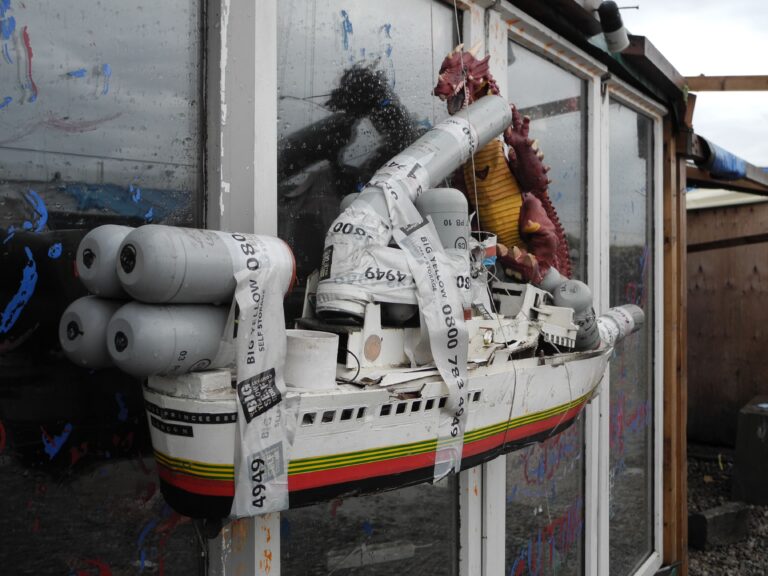
13 cases of death (20) were reported between 2018-2020: on 9 August 2019 the Iranian student Mitra Mahrad fell into the sea during a rescue operation and drowned. On 18 August 2019 the body of Niknam Massoud from Iraq was found at the Belgian Offshore windpark Thorntonback. Massoud had tried to cross the Channel on a construction made of plastic bottles. On 14 October 2019 the bodies of Hussein Mufaq Hussein and Soran Jamal Jalal were found in Le Touquet, after having an accident in a rubber boat. On 5 September 2020 the newborn baby Aleksandra H. died of anoxia after her pregnant mother was arrested before the departure. As the mother wrote in an open letter in 2021, she had not received any medical help for hours; later the baby died in hospital, after an emergency birth had to be induced.
On 19 August 2020 Abdulfatah Hamdallah was found dead on the beach of Sangatte near Calais. He wanted to cross the Channel with a friend who survived, in a children’s boat with shovels as oars. On 18 October 2020 the body of Behzad Bagheri-Parvin from Iran, who wanted to cross alone, was found in Sangatte. The biggest accident happened on 27 October 2020 at Loon-Plage when 7 Kurdish Iraqis from the camps in Grande-Synthe drowned: among them the family of Rasul Iran Nezhad and Shiva Mohammad Panahi and their children Anita (9), Armin (6) and Artin (15 months).
These cases of death were instrumentalised on a regular basis by the British government in order to claim a closure of the Channel route and to legitimate the border regime.
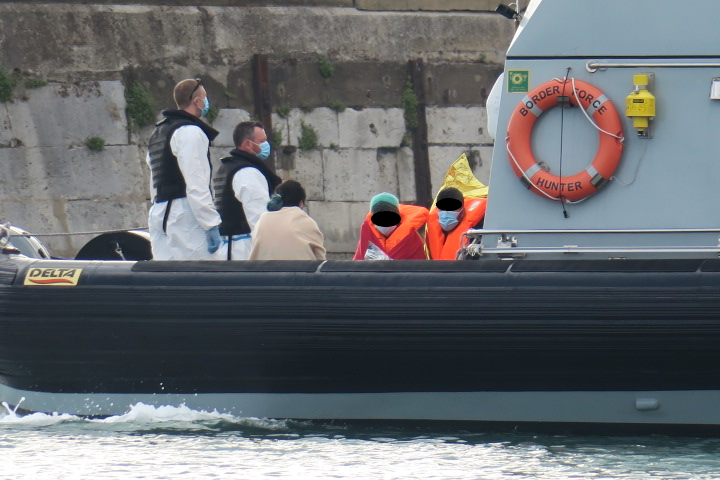
The Channel migrants became the main subject of the British national politics during the summer of 2020. The rightwing politician Nigel Farage crossed the Channel to document the alleged invasion of the island. On the British Channel coast small right wing extremist groups patrolled. British lawyers, who intervened against deportation, became targets of media and political campaigns. A lawyer was attacked with a knife on 7 September.
At the same time, however, the boats became reference points of solidarity politics – reflected in the initiatives Watch the Channel and Channel Rescue. The latter aims at providing a private ship to document the activities of government authorities in the Channel, especially pushbacks, and to give first aid in case of need.
Several British media reported that the British Home Office considered carrying out pushbacks at sea, to stop boats from entering British waters through a swimming barrier in the middle of the Channel or even by using a wave machine.
This scenario also included faraway places where successful boat passengers were to be interned, comparable with the Australian “Pacific solution”, on islands in the South Pacific or former oil platforms. This shows the radicalisation process of British migration politics, however extremely distorted it was: a “border regime on steroids” (21) as journalist Tobias Müller called it.
Meanwhile the British Government negotiated further bilateral measures with France. Great Britain applied, according to its own reports, great pressure on France to get its approval accepted for pushbacks at sea. It failed because France doubted their legality.
When Patel and Darmamin signed another deal in Calais on 22 July 2020 – after the evacuation of the Jungle -, it only regulated the “creation of a Franco-British intelligence unit on the issue of migration“[22].
The agreement supplemented existing structures of Border Police cooperation and included the use of 12 additional officials. A new agreement of 28 November 2020 went further. (23) It pledged French payments of 31,4 million Euros and aimed at doubling the French land patrols between Boulogne, Calais and Dunkerque as well as increasing the capacity of prosecution and new technical gear („rolling out a new wave of cutting-edge surveillance and detention technology“, „including drones, radar equipment, optronic binoculars and fixed cameras“) to identify boats before their departure. Patel said the aim was „to eliminate the small boats phenomenon” – hence closure of the complete Channel route.
Slowly the sea border was militarised, including national British and bilateral measures. The British migration researchers Thom Tyerman and Travis Van Isacker sum up this development in October 2020:
The main thinking manifests itself, according to them
“ (…) above all in the obvious militarisation of the Channel under ex-marine Dan O’Mahoney in the new role of Clandestine Channel Threat Commander. A fleet of coastal patrol ships from the border police and customs ships coordinate with colleagues from French prosecution authorities on both sides of the Channel to stop the boats as soon as possible.
French marine warships are used when Royal Navy and Border Force perform training. Drones from the private defense company Tekever (soon to be replaced by Elbit) and from the Ministry of Defence make constant air patrol possible next to the use of Royal Air Force planes. A video of the Home Office shows: The footage is used to criminalise refugees and to sentence travellers who steer their boats for “enabling illegal entrance“. (24)
Great Britain simultaneously tried to compensate the failure of the pushback agreement with France by forcing the deportation of Channel crossers. Under the name “Operation Sillath” the Home Office prepared collective deportations of Channel crossers to France, Germany, Italy, Spain and other third countries. The initiative Corporate Watch states (25) that prior to the deportations access to legal measures had been complicated. Those affected repeatedly defended themselves through self-injury and suicide attempts against deportation – which eventually took place by force and with a grotesque amount of security personnel.
In some cases, lawyers succeeded in stopping deportation flights at the last minute. The deportations were carried out according to EU Dublin regulations. However, they had only been valid for Great Britain until the end of the Brexit transition phase on 31 December 2020. Probably only a fraction of the announced “Sillath” deportations were realized. The discouraging effect on potential boat passengers probably never happened.
The “hostile environment” concept was still relevant, also within Great Britain. A good example is the accommodation of more than 600 Channel crossers in two former Barracks starting in Autumn 2020. (26) The Penally Barracks near Walisian Tenby as well as the Napier Barracks near Folkstone have been in the news for absolutely insufficient conditions. A report by the British Red Cross states that, based on interviews in the Penally Barracks, military facilities are completely inappropriate for the many refugees with traumatic experiences. The Napier Barracks situation soon became serious: several protests and hunger strikes happened within 4 months as well as suicide attempts and a major fire. Moreover, these kinds of accommodations do not fulfil sanitary, medical standards and social distancing-rules cannot be applied: in early 2020 there was one Covid outbreak, followed by more than 120 infected persons. (of 415).
According to statements of Kent Refugee Action Network, following social distancing-rules would have only been possible at an occupancy of up to 150 people.
The Channel route will continue to be frequented. Its militarisation will probably expand the market for commercial traffickers and also encourage people to use improvised means to cross – as e.g. Abdulfatah Hamdallah and his toy boat and Niknak Massoud with his plastic bottle construction. If the density of patrols between Boulogne, Calais and Dunkerque causes geographical relocation, the boats will have to travel longer and therefore a more dangerous distance. More hideouts in trucks will also increase the risk of deaths. “Far from preventing boat passages, saving lives or ending exploitation, this kind of border militarisation (…) has the opposite effect”, Tyerman and Van Isacker conclude.
The border regime and Brexit
In the past years there was a lot of speculation about the effect Brexit would have on migrants in Calais. In particular, it was expected that more Border and Customs controls at the Ports and at the Channel Tunnel would lead to enormous traffic jams on the motorways – which would offer good migration opportunities and at the same time legitimise more policing of the traffic ways.
After the agreement of a Transition Phase between the actual EU-exit on 31 January 2020 and 31 December 2020 the possible effects of the Brexit were postponed to the beginning of 2021. However in expectation of a no-deal-scenario, there was already increased freight traffic from October 2020 as companies wanted to avoid possible customs charges, bureaucratic processes and supply shortfall by building up stocks. The expected traffic jams in Calais really happened from October until December 2020 and refugees used them for their journeys. Near Fort Nieulay, a historic fort close to the access road to Motorway A 16 towards the loading facillities of the Channel Tunnel, migrants built camps as a starting point for this migration path. The Authorities responded with evacuations and above all, with physical violence, CS gas and the use of dogs on the migrants, seen on or near the motorway. (28) On 19 November the young Sudanese Mohamed Khamisse Zakaria died. His friends later stated: “„Mohamed died hit by a car while he was trying to escape the police gas from the back of a truck, vehicle of his desire to reach England as soon as possible.“[29]
What does the Brexit mean for the border regime?
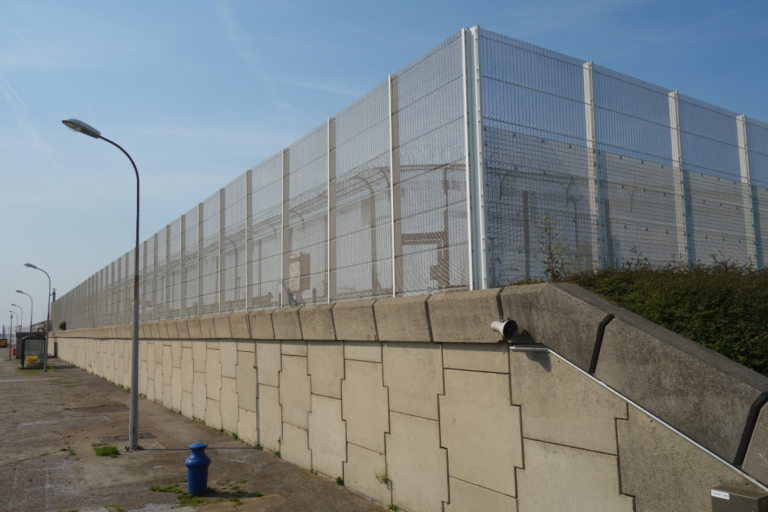
Looking into its history shows that it is based less on European Law than on bilateral agreements between Great Britain and France complemented by agreements with Belgium, as required. In addition, the border regime (until 2009) was designed for migration via traffic infrastructure ashore but not for sea passages. It is clear no one expected that the Channel route would become established.
The historical starting point of the bilateral agreements was the development of the Channel Tunnel: for the first time a “dry” border under water. Both countries handled the forefield control of this new border before the Tunnel access roads of the other country via The Treaty of Canterbury of 12 February 1986 (30) – thus the externalisation of the British controls on French territory and the other way round.
Prior to the opening of the Tunnel the Protocol of Sangatte of 25 November 1991 (31) regulated the exact process for the shuttle trains. An additional protocol of Sangatte from 25 May 2000 (32) and the treaty of Le Touquet (4 February 2003) (33) extended the controls to the departure stations of the Eurostar trains in Calais, Paris and Lille resp. to the French ferry ports on the Channel and North Sea coasts.
At the trilateral meeting on 26 September 2002 in Zeebrugge the Belgian ports and the departure station of the Eurostar trains in Brussels were added to this system.
Starting with the Ferry Port in Calais, the fortification of the traffic facilities began in 2000, their costs have mainly been borne by Great Britain. At the French-British summit in Evian on 7 July 2009 an administrative arrangement (34) was concluded: it aimed at the institutionalisation of border police cooperation in order to combat migration and to investigate smugglers. Subsequently a structure of corporate contact points, communication platforms and operative units was created with direct communication channels to the Home Secretaries and new funding mechanisms. The strategic coordination was enormous even in allegedly insignificant areas as different corporate statements of the years after 2014 show, especially the paper Managing Migratory Flows in Calais (25 August 2015) [35] from the time of the Big Jungle.
In the context of the negotiations about Great Britain’s exit agreement with the EU both countries confirmed all these agreements signing the Treaty of Sandhurst on 18 January 2018 (36). The Treaty extended the corporate field of action and interpreted it as an element of a much broader “border management” – with a great number of security functions from the security of the vital traffic flows as far as terrorism combat. Until this date the agreements focused exclusively on land. The agreements after 2019 to fight boat passages present an extension of the terrestrial border regime but continue to include measures offshore, as shown above.
The border regime is not immediately affected by the Brexit since it is based on such intergovernmental agreements. However, the transformation of a border within Europe into a EU-border affects migrants indirectly. Therefore, British politics towards the Channel migrants can be both interpreted as a reaction to the development of the Channel route and also as a pre-arrangement for post Brexit times.
Another effect of Brexit on the border can be seen in a traffic management plan of the French authorities (37). In order to relieve access roads to the ferry ports at the crucial phase of traffic jams, the trucks were already controlled ahead and stopped at less key parts of the motorway. “Intelligent”, digitalized border technologies are required for this new placement of freight control – and their implementation is encouraged by the Brexit.
The biggest influence will probably be in the British asylum law. In December 2020 the government compensated the upcoming omission of Dublin deportations by modifying the process regulations of British asylum law (38). It established a basis in order to exclude Channel crossers and other immigrating migrants from the European mainland from the asylum system and to even deport them to Third Countries which they had not even entered. However, as the mandatory agreements with the third countries are missing, this revision initially only weakens the legal status of the migrants in their asylum procedure. However, it is expected that Great Britain will try to negotiate a system of corresponding re-admission agreements with France and other EU-countries.
Concerning the boat passages, the British Government had addressed the nationalist narrative of a loss of control over the border and painted the picture of a “broken” asylum system. This rhetoric corresponded to conservative Brexiteers’ thinking. Now the closure of the Channel route and the revision of the asylum system – as Brexit itself – appeared as acts to regain national sovereignty. Patel’s statements on the alleged migration crisis in the Channel were full of announcements of a radically modified asylum law for the post-Brexit era. What exactly such a future asylum law would consist of and what it means for the Calais camps, is not yet clear. However, it is likely that the production of a “hostile environment” in the French border area will remain a secret and an inhumane but essential core element of the “border management”. The border will continue to expand but it will not stop migration.
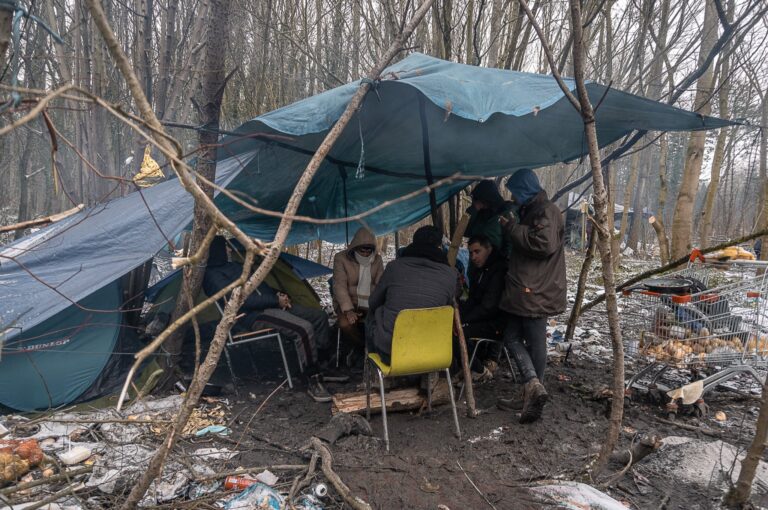
———–
Footnotes:
(1) Numerous mostly French and English publications focus on that. A good overview:
Michel Agier et al: La Jungle de Calais, Les migrants, la frontière et le camp, Paris, PUF, 2018 (engl.: The Jungle, Calais’ camps and migrants, Cambridge, Polity, 2019; dt.: Der „Dschungel von Calais“, Über das Leben in einem Flüchtlingslager, Bielefeld, Transcript, 2020). An inevitable electronic source fort he time after 2015 is this blog: https://passeursdhospitalites.wordpress.com/
[3] The cases of death are systematically documented by the group GISTI. 296 cases of death are listed for fall 2020. https://irr.org.uk/wp-content/uploads/2020/11/Deadly-Crossings-Final.pdf
After its publication 2 more cases of death became known in 2020. Plus, in early 2021 a dead body was found in the port of Calais. It was strongly decayed, and probably a migrant, therefore counted for 2020. There is probably a high number of unreported cases.
[4] Besides the already mentioned book by Michel Agier, see also: Samuel Lequette / Delphine Le Vergos (Hrsg.): Décamper, De Lampedusa à Calais, un livre de textes et d’images & un disque pour parler d’une terre sans accueil, Paris, La Découverte, 2016; Marie Godin et al: Voices from the Jungle, Stories from the Calais regugee camp, London, Pluto Press, 2017; Thomas Müller / Uwe Schlüper: Dynamiken der Jungles, Calais und das europäisch-britische Grenzregime, München: bordermonitoring, 2018; Dan Hicks / Sarah Mallet: La Lande, The Calais ‚Jungle‘ and Boyond, Bristol, Bristol University Press, 2019.
Re solidary politics compared to Athen-Calais, see also: Natasha King: No borders, The politics of immigration control and resistance, London, Zed Books, 2016.
[5] See Agier et al. a.a.O., p. 129-133, 195-199; See also Thomas Müller u. Sascha Zinflou: Die Urbanität des Jungle, Calais und die Möglichkeit einer migrantischen Stadt, in; movements 2/2018, p. 129-160.
[6] https://refugee-rights.eu/reports/the-long-wait and https://refugee-rights.eu/wp-content/uploads/2018/08/RRE_UnsafeBorderlands.pdf
See also: https://refugee-rights.eu/wp-content/uploads/2018/08/RRE_StillWaiting.pdf
https://refugee-rights.eu/wp-content/uploads/2018/08/RRE_StillHere.pdf
https://refugee-rights.eu/wp-content/uploads/2018/08/RRE_TwelveMonthsOn.pdf
[7] https://helprefugees.org/wp-content/uploads/2018/08/Police-Harrassment-of-Volunteers-in-Calais-1.pdf
http://www.laubergedesmigrants.fr/wp-content/uploads/2020/07/HRO-eng-rep2019.pdf
[8] See also reports by Human Rights Watch https://www.hrw.org/report/2017/07/26/living-hell/police-abuses-against-child-and-adult-migrants-calais
and Amnesty International https://www.amnesty.org/download/Documents/EUR2103562019ENGLISH.PDF
https://juridique.defenseurdesdroits.fr/index.php?lvl=notice_display&id=18378&opac_view=1
[10] See Corporate Watch: The UK Border Regime, A critical guide, London, Freedom Press, 2018, S. 23ff.
[11] Human Rights Observers observe the situation constantly according to a scheme: short reports are published on Twitter about each evacuation. Also, the group presents monthly and yearly reports.
[12] https://calais.bordermonitoring.eu/2020/07/20/rekonstuktion-einer-raeumungswoche/
[13] https://calais.bordermonitoring.eu/2020/09/30/neue-dimension-von-raeumungen/
[14] https://calais.bordermonitoring.eu/2020/12/26/kampf-um-plaetze-2/#more-1673
[15] https://calais.bordermonitoring.eu/2020/09/15/cest-lhonneur-de-la-france/
[16] Compare interview with activist Maya Konforti: https://calais.bordermonitoring.eu/2020/05/15/whats-happening-is-crazy-its-inhum ane-it-doesnt-work-but-its-going-to-continue/
as well as the survey https://calais.bordermonitoring.eu/2020/10/11/analyse-zum-einfluss-der-pandemie-auf-die-lage-der-exilierten/
and the blog https://calais.bordermonitoring.eu/2020/11/14/zweite-welle-ein-lagebericht/
[18] About the origin of the Channel route see Thomas Müller / Uwe Schlüper / Sascha Zinflou: Querung des Kanals, Calais, der Brexit und die Bootspassagen nach Großbritannien, München: bordermonitoring, 2019. About the further development see Tobias Müller: Das Elend von Calais, Der Brexit und die Bootsflüchtlinge, in: Blätter für deutsche und internationale Politik 11/2020 https://www.blaetter.de/ausgabe/2020/november/das-elend-von-calais-der-brexit-und-die-bootsfluechtlinge
The numbers in the following are taken from BBC and The Guardian as well as the connection of further official and media data via Pottal Migration Watch (rightwing).
[20] Besides the mentioned survey by GISTI (see footnote 3) here is an interview with Maël https://calais.bordermonitoring.eu/2021/01/07/ich-halte-das-recht-auf-freizuegigkeit-fuer-die-beste-loesung/#more-1728
ergänzt durch https://calaismigrantsolidarity.wordpress.com/2021/01/29/in-the-name-of-god-au-n om-de-dieu/
[21] https://jungle.world/artikel/2020/34/grenzregime-auf-steroiden
[22] https://www.france24.com/en/20200712-france-and-britain-agree-to-form-joint-uni t-to-fight-migrant-trafficker
https://www.gov.uk/government/news/uk-and-france-sign-new-agreement-to-tackle-illegal-migration
[25] https://corporatewatch.org/cast-away-the-uks-rushed-charter-flights-to-deport-channel-crossers/
as well as https://corporatewatch.org/hi-fly/
[26] https://calais.bordermonitoring.eu/2021/02/06/feindliche-umgebung-in-reinform/#more-1825
[28] https://calais.bordermonitoring.eu/2021/01/15/ein-ruhiger-brexit-weniger-staus-und-neue-zaeune/
[30] https://treaties.un.org/doc/Publication/UNTS/Volume%201497/volume-1497-I-257 92-English.pdf
[34] https://www.gisti.org/IMG/pdf/arrangement_2009-07-06_franco-brit.pdf
[37] https://www.lavoixdunord.fr/913094/article/2020-12-28/avec-le-brexit-faut-il-craindre-desormais-des-bouchons-recurrentsurla16?referer=%2Farchives%2Frecherche%3Fdatefilter%3Dlastyear%26sort%3Dd ate%2520desc%26word%3Dmigrant
